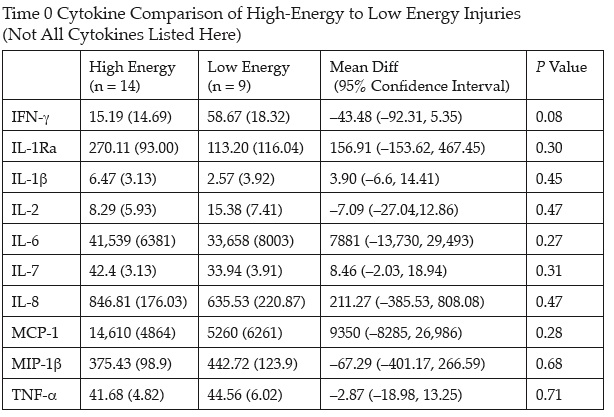
Session V - Knee / Tibia
Fri., 10/11/13 Knee/Tibia, PAPER #59, 2:36 pm OTA 2013
Δ Inflammatory Cytokine Response Following Tibial Plateau Fracture Does Not Correlate with Fracture Grading of “Low Versus High Energy”
Justin Haller, MD; Erik Kubiak, MD; Thomas F. Higgins, MD;
University of Utah, Salt Lake City, Utah, USA
Purpose: This study is designed to evaluate the inflammatory cytokine response following intra-articular tibial plateau fracture. Prior studies have linked both inflammatory response and grade of injury to the development of arthritis, and we hypothesized that higher grade fractures would have a more robust inflammatory response.
Methods: After IRB approval, investigators prospectively aspirated synovial fluid from the injured and uninjured knees of 23 patients with tibial plateau fractures who were between the ages of 18 and 60 years. Patients with open fracture, history of autoimmune disease, preexisting arthritis, or presentation greater than 24 hours from injury were excluded. The 10 patients requiring spanning external fixator followed by definitive fixation were aspirated at both surgeries. The concentrations of 15 inflammatory cytokines (interferon [IFN]-γ, interleukin [IL]-2, -4, -6, -7, -8, -10, -12 (p70), -13, -17, -1β, -1Ra, tumor necrosis factor [TNF]-α, monocyte chemotactic protein [MCP]-1, and macrophage inflammatory protein [MIP]) were quantified using a human inflammatory cytokine multiplex panel.
Results: We enrolled 23 patients (9 females, 14 males), with an average age of 44.3 years (range, 20-60). There were 9 low-energy (OTA 41B or Schatzker 1-3, all OTA 41B) tibial plateau injuries and 14 high-energy (Schatzker 4-6) tibial plateau injuries. Of the high-energy fractures, 5 were OTA 41B3 and 9 were OTA 41C. There was a significant difference between injured and uninjured knees in all cytokines except IL-1β, IL-1Ra, IL-2, IL-7, and IL-12p70 (P = 0.15, 0.20, 0.08, 0.10, 0.11, respectively). There was no difference in inflammatory response between high- and low-energy injuries for any of the cytokines (see table below). IL-7, MCP-1, and TNF-α all remained elevated at an average of 8.5 days from initial surgery. While not significant, IL-1Ra experienced an increase in concentration between the two time points (P = 0.24). All other cytokine concentrations decreased between index and secondary surgery.
Conclusion: There is a significant inflammatory response in most of the cytokines tested in the injured knee compared to the control knee, demonstrating the effect to be local, not systemic. Most surprisingly, there was no difference in inflammatory response between high- and low-energy injuries. While there is an established link between inflammatory cytokines and the development of arthritis, in these patients with articular injury, the inflammatory response is not correlated to the grading systems commonly used to distinguish high energy versus low energy.

Alphabetical Disclosure Listing
• The FDA has not cleared this drug and/or medical device for the use described in this presentation (i.e., the drug or medical device is being discussed for an “off label” use). ◆FDA information not available at time of printing. Δ OTA Grant.